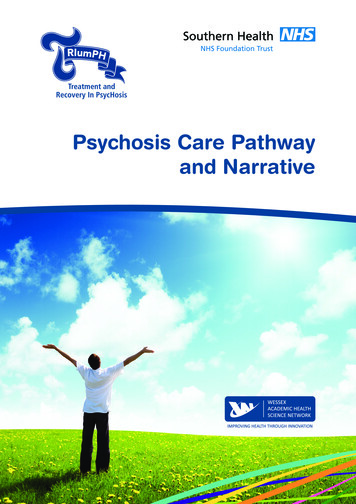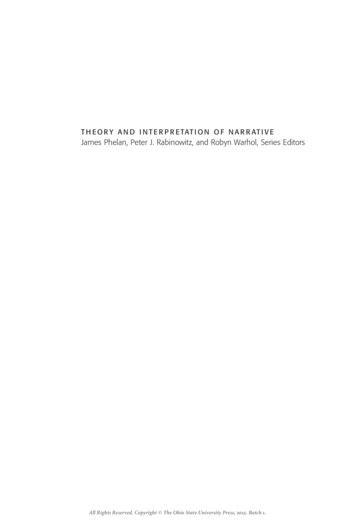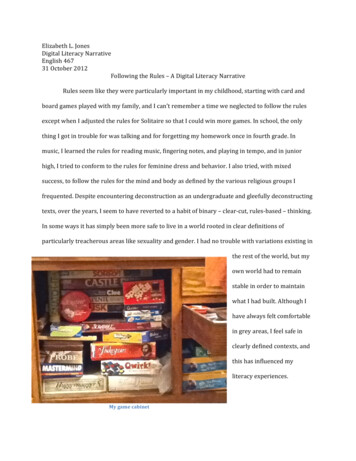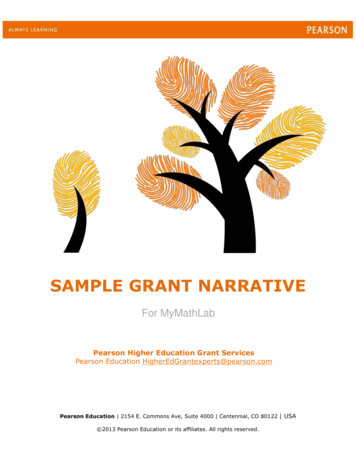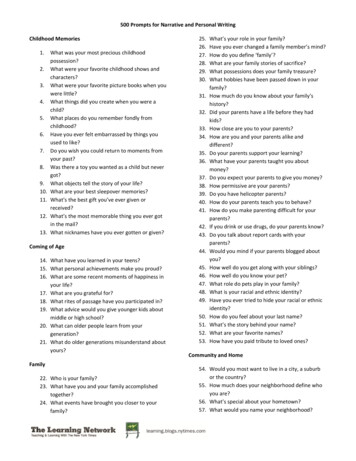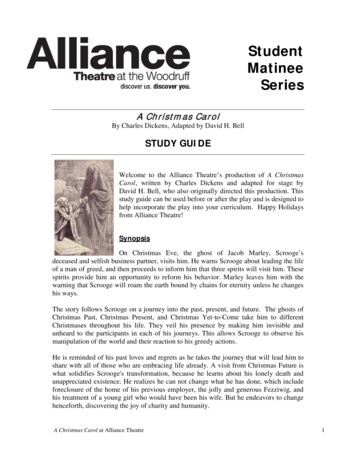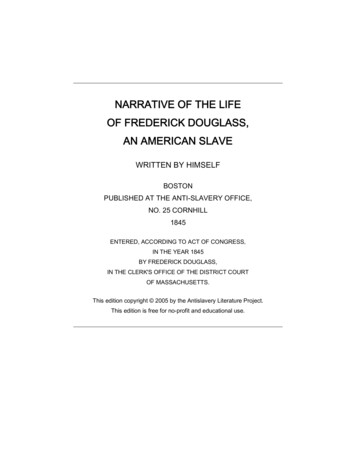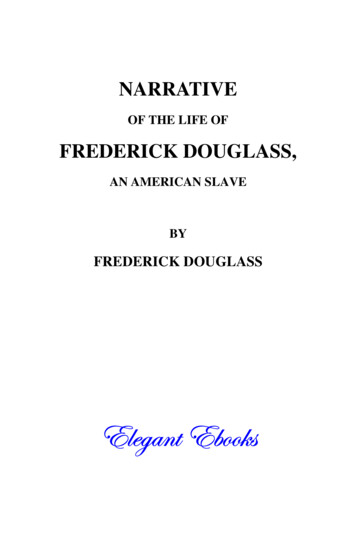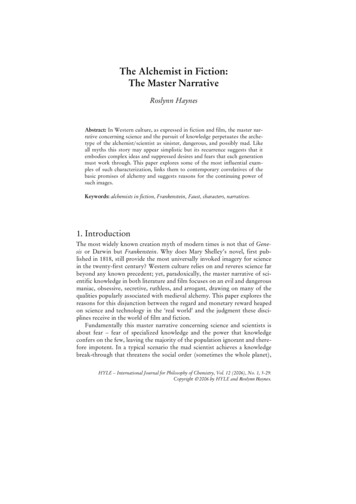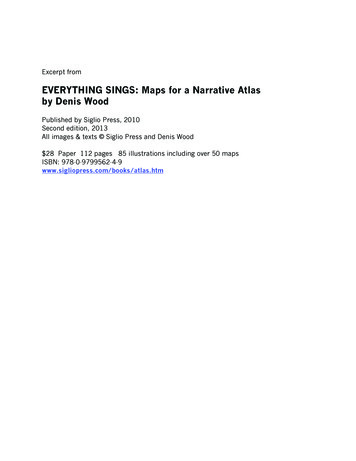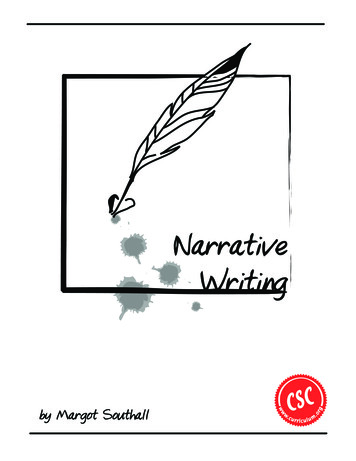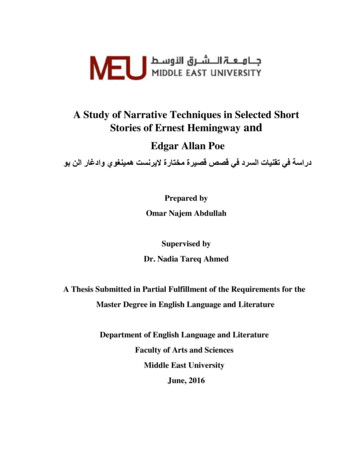
Transcription
A Study of Narrative Techniques in Selected ShortStories of Ernest Hemingway andEdgar Allan Poe دراسة في تقنيات السرد في قصص قصيرة مختارة اليرنست همينغوي وادغار الن بو Prepared byOmar Najem AbdullahSupervised byDr. Nadia Tareq AhmedA Thesis Submitted in Partial Fulfillment of the Requirements for theMaster Degree in English Language and LiteratureDepartment of English Language and LiteratureFaculty of Arts and SciencesMiddle East UniversityJune, 2016
II
III
IVAcknowledgmentsI wish to thank my Supervisor Dr. Nadia Tareq Ahmed for her valuable time in helpingme. I am also grateful to my English department and to the faculty members forsupporting me in the completion of this thesis.
VDedicationTo the greatest mother who keeps on supporting me emotionally and spirituallyand helped me to read the first of my letters when I was a child.To my father’s soul who has not able to see me in this day because of war.To my lovely great country, IRAQ,
VITable of contentsSubjectAThesis TitleIBAuthorizationIICThesis Committee DecisionIIIDAcknowledgmentsIVEDedicationVFTable of ContentsVIGEnglish AbstractIXHArabic AbstractXIChapter One Introduction1.0Introduction1Background of the study1.111.2Statement of The problem51.3Objectives of the study51.4Questions of the Study61.5Significance of the study61.6Limitation of the study61.7Definition of key Terms7
VIIChapter Two : Review of Related Literature2.1Theoretical review92.2Empirical review15Chapter Three : Methods and Procedures3.1Research Methodology203.2Methods203.3Procedures21Chapter four: Discussion4.1.1Night before Battle224.1.2The Butterfly and the Tank274.1.3The Old man at The Bridge304.1.4Hemmingway’s Embodiment of Modernism in his Short33StoriesEdgar Allan Poe364.2.1The Black Cat364.2.2The Fall of the House of Usher404.2.3The Tell-Tell Heart434.2.4Poe’s Embodiment of Romanticism in his Short Stories464.2
VIIIChapter five5.1Conclusion495.2Recommendations515.3Further studies51References52
IXA Study of Narrative Techniques in Selected Short Stories of ErnestHemingway and Edgar Allan PoePrepared byOmar NajemSupervised byDr. Nadia Tarik AhmedAbstractThe present study deals with Narrative Technique in the short stories of both ErnestHemingway and Edgar Allan Poe. Narrative technique means the analysis of the variouselements of the story such as setting, character, point of view, mood or atmosphere,symbolism, style, theme, etc. In other words it is the logical sequence of events presented tothe readers in a way that enables the author to convey the themes, which are embodiedwithin the literary work. The literary achievements of both authors in the short story genrecannot be overemphasized. They seek to present many social and moral issuesconcentrating on social criticism of people’s behavior when their environments are violatedeither by the savagery of civil war as in the case of Hemingway or by psychological statesas in Poe. The study consists of five chapters .The first one is an introduction which beginswith an overview of the narrative technique and its types as well as the way in which ErnestHemingway and Edger Allan Poe use their talent in short stories. The second chapter is areview of literature that presents different studies, opinions and approaches that discuss the
Xtheoretical and empirical sides of the narrative technique of Ernest Hemingway and EdgerAllan Poe. Three shows the procedures and methods used by the researcher to present thisstudy. Chapter Four is the core of the study in that it gives a detailed analysis thematicallyand technically. Chapter Five is the conclusion, where the main points of the study arerecaptured and emphasized.Key words: Narrative Technique, short story, Hemingway, Poe, literary movements,Modernism
XI دراسة في تقنيات السرد في قصص قصيرة مختارة اليرنست همينغوي وادغار الن بو إعداد عمر نجم عبد هللا بإشراف الدكتورة نادية طارق احمد ملخص تتعلق هذه الدراسة بالتقنيات السردية المستخدمة من قبل كل من ارنست همينغوي وادغر الن بو في كتابة القصة القصيرة حيث أن التقنيات السردية في القصة القصيرة تعني تحليل العديد من العناصر الخاصة بالقصة مثل : المكان والشخصيات ووجهة النظر الخاصة بالكاتب والحالة والجو العام للقصة وكذلك الرمزية واألسلوب والفكرة وبعبارة أخرى يمكن أن تعتبر التقنيات السردية كسلسلة منطقية من األحداث مقدمة إلى القارئ بصورة تمكن الكاتب من نقل المواضيع الذي يتضمنه العمل األدبي . إن االنجازات األدبية لكال الكاتبين ال يمكن تغطيتها بصورة كاملة . حيث أنهما بحثوا عن تقديم الكثير من المواضيع االجتماعية واألخالقية والتي تركز على النقد االجتماعي لتصرفات الناس عندما تتعرض بيئتهم النتهاك سواءً بسبب الحرب األهلية الوحشية فيما يخص همينغوي أو بسبب األبعاد النفسية لإلنسان فيما يخص ادغر الن بو . هذه الدراسة تحتوي على خمسة فصول حيث ان الفصل األول هو عبارة عن مقدمة والذي تبدأ بنظرة شاملة لألسلوب التقني الروائي وأنواعه ، وكذلك الطريقة التي استخدمها همينغوي وادغر الن بو في مهارات كتابة القصة القصيرة . أما الفصل الثاني فهو مراجعة للدراسات األدبية وتقديم الدراسات
XII المختلفة واآلراء والنظريات التي ناقشت الجوانب الفكرية والتطبيقية لألسلوب السردي لهمينغوي وادغر الن بو , و الفصل الثالث يحتوي على اإلجراءات والطرق التي استخدمت من قبل الباحث لطرح دراسته , و الفصل الرابع يحتوي على الهدف الرئيسي للدراسة موضوعيا وتقنيا , اما الفصل الخامس فأن ة يشتمل على االستنتاجات والنقاط الرئيسية التي تم التوصل إليها وإيضاح األهداف المستقاة من هذه الدراسة . الكلمات المفتاحية : تقنيات السرد ، القصة القصيرة ، هيمنجوي ، بو , الحركات األدبية , الحداثة
1Chapter oneIntroduction1.1 Background of the study:Narrative technique is the logical sequence of events presented to the readers in away that enables the author to show his talent in conveying the themes which are embodiedwithin the literary work whether it is a novel or a short story. There are several types oftechniques that can be found in many novels or short stories and are important for anywriter to think about when beginning writing a literary work.Any writer who starts to plan the framework of his fiction must choose the point of viewthat contains the perspective from which an author chooses to tell the story. It determineswhich characters' thoughts and feelings are accessible to the reader. For example, in thethird person omniscient point of view, the narrator of the story is not a character within thestory but an authoritative figure to present the events, and who is able to access the thoughtsand feelings of all the characters. Second, is the first person limited point of view, where thereader focuses on a single character and only has access to this person's thoughts andfeelings. In the first person point of view, the narrator is a character in the story whodirectly relates his experiences. Third, is the second person point of view, where thenarrator directly addresses a "you," the reader, sharing what he or she does, feels and thinks.
2The narrative is a way of organizing episodes, actions, and accounts ofactions; it is an achievement that brings together mundane facts and fantasticcreations; time and place are incorporated. The narrative allows for theinclusion of actors reasons for their acts, as well as the causes of happening.(Sarbin,.1986).Therefore, the first function of the narrative technique is to determine the manner of sendingthe information to spectators. After that, when people (persons who are created by theauthor inside the novel) or what is known as the characters begin to speak, then the authorneeds a dialogue that characters use to tell their stories. This technique has two types; thefirst one is the dialogue which is directly spoken by two characters. Authors often signifydialogue with quotation marks and a dialogue tag like "he said" or "she whispered”. Thefunction of the dialogue is to enable the authors to create scenes in which characters speakto one another and voice their thoughts and feelings. The second type is when the authorspeaks about himself or his feeling.After choosing the way in which the author will narrate the story and the manner by whichthe characters can speak, he then needs to specify the time in which the events of the storytook place. When the storyline jumps backward to show something that has happenedbefore the main event of the novel and that has relevance to the present story, or when thewriter speaks and remembers some event that happened in the past and have importance tolead the reader to the central present event, then this is called a flashback. He can also useforeshadowing, when the narration hints at things that will happen but have not happenedyet. This is known as Shifts in Time. Authors might also use a frame story, which is asecondary story that is not the main story of the novel or short story but through which the
3main story is told. We can see that in Joseph Conrad's Heart of Darkness when a characterin the present remembers what has happened in the past.When you read a story, and before you begin writing an analysis, youshould examine the various elements of the story and ask yourself specificquestions: Setting: Where and when is the story set? Is the settingsignificant? If so, why? Character: Who are the main characters? (Lookbeyond the obvious.) What makes these characters act as they do and saywhat they say? What is their motivation? How do other characters relate tothem? Is there more to them than meets the eye? Mood: How does storymake you feel: happy, nostalgic, revolted, or frightened, etc? How does themood relate to the story’s meaning? Symbolism: Does anything in the story– an object, person, animal, detail, etc. – represent something other thanwhat it appears to be on the surface? If so, how does this symbolicrepresentation function within the story? Style: Look at the writer’ssentence structure and vocabulary. Does he or she use long, convolutedsentences like William Faulkner or short, concise sentences like ErnestHemingway? Theme: What is the underlying meaning of the story? Why doyou think this? What evidence from the story supports your deduction?(Schwiebert, 1997)
4In this quotation we see that Schwiebert gives us the principal elements which help us toanalyze a short story. Any reader who tries to read a short story will find himself indulgingin deep analyses in order to get the idea behind the story. Therefore, this thesis tries to shedlight on Ernest Hemingway’s and Edgar Allan Poe’s short stories and their narrativetechniques, points of view and themes.Ernest Hemingway and Edgar Allan Poe were fascinating writers. Their works areresourceful in terms of their bright and vivid literary techniques. Hemingway was born andraised in a blooming Chicago town. He wanted to be a writer. He achieved his goal andbecame modernist writer. He started working on his high school newspaper. He wanted tojoin the army, but he was turned down because of an injury. Poe’s life could be consideredequally tragic. His father left his family when he was still a baby and his mother died fromtuberculosis. He joined the army for a short time. Poe’s and Hemingway’s lives were verysimilar. They became alcoholics and struggled with this problem until the end of their lives.They also both had fine life styles and lived simply to please themselves.Poe and Hemingway presented many themes that deal with social issues, questions ofdeath, war, the effects of breakdown, brutality and violence, and other themes. Theyconcentrated on different narrative technique to share their ideas, concepts and attitude.Poe’s works are generally considered as part of the dark romanticism genre, a literaryreaction to transcendentalism which is a philosophical movement and which Poe stronglyhated. Hemingway’s works deal with issues like war and suffering. Since he experiencedwars, he chose to write many stories which deal with this theme, by using the first personnarrator in order to show how these stories are related to his personal life.
51.2 Statement of the problem:Through reviewing other researches and studies, the researcher found that there is ashortage in the studies that explore the role of the narrative technique of the short stories ofthe selected works of Hemingway: "The Butterfly and the Tank", "Night Before Battle”,"The Old man at The Bridge”, and Edger Allan Poe’s “The Tell-Tale Heart”, “The BlackCat", "Fall of the House of Usher”. In order to get a deeper understanding of the narrativetechnique, this study sheds light on the different narrative techniques used by these twogreat writers and the movements which they belong to.1.3 Objectives of the study:This study aims at:-Highlighting the narrative techniques and the points of view in Hemingway’s three selectedshort stories “The Butterfly and the Tank,”“Night Before Battle” and " The Old man at TheBridge.”-Highlighting the narrative techniques and the points of view in Edger Allan Poe’s threeshort stories “The Tell-Tale Heart,”“The Black Cat, "and “Fall of the House of Usher”.-Pointing out the relationship between narrative techniques and the features of the isms thatErnest Hemingway and Edgar Allan Poe followed.
61.4 Significance of the studyThe present study explores the thematic and technical views of Hemingway’s andEdgar Allan Poe’s short stories, the importance of narrative technique in analysis andcriticism.1.5 Questions of the Study:The researcher attempts to answer the following main questions:1. How has the choice of narrative technique influenced Hemingway’s construction of themeand technical view?2. How has the choice of narrative technique influenced Poe’s construction of theme andtechnical view?3. What are the features of the literary movements that Hemmingway and Poe used to createtheir narrators?1.6 Limitations of the StudyThe limitation of this study is attributed to the nature of methodology and the studysample. It discusses the works of two authors, Ernest Hemingway and Edgar Allan Poe.Therefore, the analysis is limited to the number of the selected work. So, it cannot begeneralized to their other works.
71.7 Definition of Key Terms:1. Short story:A short story is a fictional work of prose that is shorter in length than a novel. Edgar AllanPoe, in his essay "The Philosophy of Composition," says that a short story should be read inone sitting, anywhere from a half hour to two hours. In contemporary fiction, a short storycan range from 1,000 to 20,000 words. Because of the shorter length, a short story usuallyfocuses on one plot, one main character (with a few additional minor characters), and onecentral theme, whereas a novel can tackle multiple plots and themes, with a variety ofprominent characters. Short stories also lend themselves more to experimentation — that is,using uncommon prose styles or literary devices to tell the story.2. Narrative technique:“Narrative technique means the methods and devices writers use to tell their stories,whether in works of literature, film, theater or even oral stories or other media. Manytechniques work upon specific uses of phrases, punctuation or exaggerations of description,but nearly every storyteller, regardless of genre or style employs a few foundationaltechniques, such as point of view, setting, symbolism and others.” (Cascio,2007)3. Gothic: According to Cengage (2009),Gothic literature, a movement that focused on ruin, decay, death, terror, andchaos, and privileged irrationality and passion over rationality and reason,grew in response to the historical, sociological, psychological, and politicalcontexts of the late eighteenth and early nineteenth centuries. Although
8Horace Walpole is credited with producing the first Gothic novel, TheCastle of Otranto, in 1764, his work was built on a foundation of severalelements. First, Walpole tapped a growing fascination with all thingsmedieval; and medieval romance provided a generic framework for hisnovel. In addition, Edmund Burke’s 1757 treatise, A Philosophical Enquiryinto the Sublime and Beautiful, offered a philosophical foundation. Finally,the Graveyard School of poetry, so called because of the attention poetsgave to ruins, graveyards, death, and human mortality, flourished in the mideighteenth century and provided a thematic and literary context for theGothic.4. Modernism: Rahn (2011) mentioned that Modernism is a literary movement that beganin the late 19th and early 20th centuries in Europe and America. The main features of thismovement are characterized by a conscious break with traditional styles employed inliterary works. This literary movement presented new ways of expressions of the new deepfeelings of their times. The aggression and agony of wars made a new reconsideration ofthe social, cultural and aesthetic values and assumptions necessary and realistic.
9Chapter TwoReview of Related LiteratureThe present chapter presents some books and articles which help in shedding somelight on the reaction to and judgment of Ernest Hemingway and Edger Allan Poe's narrativetechnique in their short stories.2.1 Theoretical ReviewKlinger (2015) argues that “Edgar Allan Poe did not invent the tale of terror. Therewere American, English, and Continental writers who preceded Poe and influenced hiswork. Similarly, there were many who were in turn influenced by Poe’s genius andproduced their own popular tales of supernatural literature. Klinger said that thesupernatural fiction of Edger Allan Poe’s narrative technique is a term that refers to variousliterary genres including imaginary creatures, settings outside of this world and events thatdefy natural laws. A comprehensive and precise classification of supernatural fiction has notbeen made but it is generally accepted that genres like horror stories, ghost books, fantasiesand tales of vampire are included in this category.”Klotz (2011) stated that Edgar Allan Poe had a unique and dark way of writing. He alsoanalyzed Poe’s style and came up with conclusion thatHis [Poe’s] mysterious style of writing and narrative technique appeals toemotion and drama. Poe’s most impressionable works of fiction are Gothic.His stories tend to have the same recurring theme of either death, lost love orboth. For example, the short story ” The Cask of Amontillado” opens with afirst person narrator (Montresor) who speaks of his plan to kill Fortunato.
10The character Montresor states, "I must not only punish, but punish withimpunity” Poe has a brilliant way of taking Gothic tales of mystery andterror and mixing them with variations of a romantic tale by shiftingemphasis from surface suspense and plot pattern to his symbolic play inlanguage and various meanings of words. Poe uses a subtle style, tone,subconscious motivation of characters and serious themes to shift his readerstowards a demented point of view. This is the unique tactic Poe utilizes thatmakes him an impressionable writer and poet.Bradford (2010) showed that “the way in which the work of nineteenth-century Americanauthor, Edgar Allan Poe, borrowed from, challenged, and even worked to support prevailingcultural attitudes, conventions, and ideas regarding death, mourning and memorializing.Bradford explained how the writer draws upon literature, ritual, and material practices ofthis culture, and how, in turn, this culture provided an interpretive framework forunderstanding the narrative technique of such work”.Stewart (2009) wrote about Hemingway’s writing style in an attempt to guide students andteachers towards a better understanding of Hemingway’s complex works. He said that “itprovides a reading of each story and literary epigraph. For instance, Hemingway’s influencehas been even more pronounced in the realm of prose style, an emphasis on nouns and verbsrather than adjectives and adverbs. This is closely related to Hemingway's preference for theactual versus the abstract. Hemingway was fluent in three languages: French, Spanish, andItalian. Each of these has a much smaller vocabulary than English, and yet each manages tobe richly expressive.”.
11McDaniel (1996) said that “the background information and the variety of the primarysources help readers to separate Ernest Hemingway from the many myths that surroundedhim.” She also showed the significance of “Hemingway's writings and quotes to illustratehow his work often mirrored or was influenced by his life. This is an objective account,admiring the man's desire to experience life fully and his enormous talent, but alsoexamining his often cruel and erratic behavior, problems with alcohol, and battles with theemotional problems that eventually led to his suicide. His Tragic sense appears throughouthis technique and style. Therefore most of Hemingway’s works were written for adults.”Samuelson’s (1992) study stated thatIn Hemingway, personality competes with prose. He said that fewAmerican authors have cultivated their media image, their private mystique,like Ernest Hemingway. The Hemingway presence and celebrity depend, ofcourse, on his roles as war hero, big game hunter, deep sea fisherman,aficionado of bull fighting, husband of four wives, and cavorter with thefamous and rich. Ironically these guises tend to shadow Hemingway's workas a writer but serve to qualify him as an American character. And after theimage hype, it is refreshing to return to the fiction, to see the hero—victimsthat permeate his writing and ring, in some ways, more true than the life oftheir creator. But even in returning to the fiction we may be victims of ourpreconceptions of the man.
12According to Ferreira (1978), “Poe’s scientific stories such as the character of the murdererwho is the brutal murderer who killed two women in “The Rue Morgue and The Mystery ofMarie Roget” (1841) were deeply influenced by the scientific developments of his time.This period was, in the United States, an era of invention and innovation in all branches ofscience. Poe's fascination with science can be traced throughout his life, although hesometimes showed himself an opponent of industrialism and of certain scientificprocedures. Poe wrote many tales in which he deals with exact or practical applied sciences;tales related to physics, chemistry, geography, astronomy, zoology, botany and scientificinventions. He also treated pseudo— scientific subjects such as alchemy and phrenologywhich were very obvious through his own narrative technique.”Benson’s (1975) study “provides the first comprehensive anthology of criticism of ErnestHemingway's masterful short stories. Since that time the availability of Hemingway'spapers, coupled with new critical and theoretical approaches, has enlivened and enlarged thefield of American literary studies. His argument also reflects current scholarship and drawstogether essays that were either published during the past decade or written for thiscollection which illustrate the seriousness and romantic tradition of Hemingway and hisnarrative technique in short stories and novels.”
13Barthes (1975) assesses two main categories for the narrative structure: elements whichstand the action and present information and initiate consequent events. He said that:In order to classify a function as cardinal, all we need verify is that theaction to which it refers opens (or maintains or closes) an alternative directlyaffecting the continuation of the story, in other words, that it either initiatesor resolves an uncertainty. If in a fragment of narrative the telephone rings,it is equally possible to answer or not to answer the call, procedures that arebound to carry the story along different paths. On the other hand, betweentwo cardinal functions, it is always possible to bring in subsidiary notations,which cluster around one nucleus or another, without modifying its alternative nature: the space separating "the telephone rang" from "Bond picked upthe receiver" can be saturated with countless minor incidents or descriptions,such as "Bond made his way to the desk, picked up the phone, put down hiscigarette." These catalyses are still functional, insofar as they enter intocorrelations with a nucleus, but their functionality is toned down, unilateral,parasitic.Yalom’s (1971) study of “Hemingway is an attempt to illuminate the underlying forceswhich shaped the content and structure of his work. This artist was not only known by hisstylistic genius of far-reaching literary influence, but also he was both a mirror to andarchitect of the 20th-century American characters and conflicts that were drawn by thebrilliant style of Hemingway who struggled all his life with severe problems and, in a
14severe paranoid depression, committed suicide. Yalom presented the major psychologicalconflicts apparent in Hemingway’s life style and fiction, which led to that event.”Moritz (1968) said that Hemingway’s narrative techniques were used effectively as a meansto present his ideas. He also found that “one observation that can be made on Hemingway’snarrative technique as shown in his short stories is his clipped, spare style, which aims toproduce a sense of objectivity through highly selected details. Hemingway refuses toromanticize his characters. Being “tough” people, such as boxers, bullfighters, gangsters,and soldiers, they are depicted as leading a life more or less without thought. The world isfull of such people, and it is unrealistic to put sublime thoughts into their heads. So,Hemingway writes about them in their own instinctive and thoughtless language.”Wang (1925) presented a comparison between the narrative techniques, aesthetic thoughtsand themes of Poe’s works with those of Modernist writers. He argued thatEdgar Allan Poe (1809-1849), the famous American short story writer, poetand critic, is one of the most important forerunners of Modernism and thatPoe’s works have provided the writers in the mainstream of the Modernistmovements with literary inspirations and theoretical bases. Both the worksof Poe and those by the Modernist writers depicted the alienated and isolatedcharacters subject to self-fragmentation and self-destruction in a world ofwasteland devoid of any meaning and significance. Poe’s strong sense ofspiritual alienation and isolation in society embodied in his literaryprotagonists provided a perfect model for the Modernists.
152.2 Empirical Studies:Abood’s (2013) study claims that “the narrator of Poe's short story "The Tell-TaleHeart" provides an example of an unreliable narrator. The narrator's unreliability relies onhis attempts to confuse the reader, to digress and thus bury his omission of relevantinformation. For this to be detected, the study has taken into consideration the narrator'slimited knowledge, his personal involvement in the event, and his problematic valuescheme. The study has proved the narrator unreliable by his unnecessary repetitive andquestionable expressions. Throughout the whole story the word “mad”, for example, is usedby the narrator to convey that he is not mad but has developed a sense of acute hearing; asense which only proves the contrary.”Rhea (2013) states thatEdgar Allan Poe wrote “The Black Cat” and “The Tell Tale Heart” in anarrative voice. In writing the stories he uses the narrator to tell aboutwhat happened and the acts that were involved when he did what he did.When telling the stories in first person as Poe did, it is hard to determinethe real from the false in this type of narrative, as it was with Poe too. Hetold his stories from the mind of a madman, per se. He tells both storiesfrom the mind of a mentally ill person or from a diseased mind as in “TheTell-Tale Heart”. “The disease had sharpened my senses, not destroyed,not dulled them.” (The Tell Tale Heart) He talks about his disease,referring to his alcoholism being a mental disease. He proves many timesthroughout the story that he is a mad man. He talks about killing the oldman because his eye reminded him of a bird, just the craziness of the
16human psyche. Poe has a way of showing and defining the human psychein a demonic fashion, and yet at the same time act like he is not mad andthat is what any normal person would do if they are bothered bysomething or someone.Domotor (2012) sets out to investigate “the ambiguous concept of American heroism inErnest Hemingway's short story collection entitled In Our Time (1925). It investigates theauthor's interpretation of Americanness in its social context during the Roaring Twenties,because visions of manliness have always been crucial in defining what it means to be anAmerican. His study also argues the prominence to Hemingway's representation ofmasculinity. The surface of his text conforms to contemporary Midwestern definition ofmanhood. Accordingly, as existing scholarship asserts, Hemingway's American hero istraumatized in physical and emotional terms, but he conceals his weakness and he comes toterms with his loss, which essentially signifies his American optimism. With the help ofmen's studies, psychoanalysis and narrative theory, this study analysis and reveals adifferent type of man existent in Hemingway's literature by using special narrativetechnique .”Robinson ( 2010) argues thatHemingway’s narrative style in the short story involves terse sentences,simple sentenced phrases, and a dearth of adjectives and adverbs His style isoften understood by critics as implying that Hemingway’s talent is infocusing on the concrete details conveyed in the narrative versus a moreomniscient illustration of events and actions. However, accepting thislimited focus dismisses Hemingway’s various attempts to capture in his
17narratives “the actual things which produced the emotion that heexperienced". He is echoing the desires of his peers appearing in narrativestructures of texts and wants to move beyond mere recordings of life in hisnarratives.Jasná (2010) tries to find a connection between the theme of dignity appearing inHemingway′s short story writing and in his life. He also draws inspiration from experiencesthat influenced him so this study also looks at correlations with historical events. In hismemoir, A Moveable Feast, h
4.2 Edgar Allan Poe 36 4.2.1 The Black Cat 36 4.2.2 The Fall of the House of Usher 40 4.2.3 The Tell-Tell Heart 43 4.2.4 Poe’s Embodiment of Romanticism in his Short Stories 46 . VIII Chapter five 5.1 Conclusion 49 5.2 Re
